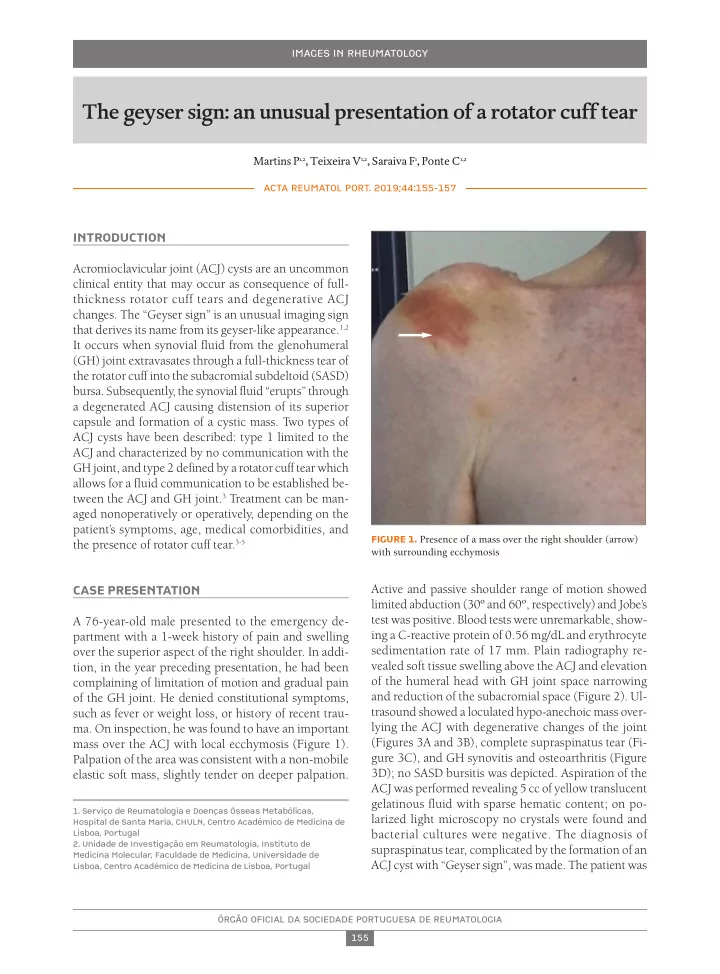

IMAgES IN RHEUMATOLOgy The geyser sign: an unusual presentation of a rotator cuff tear Martins P 1,2 , Teixeira V 1,2 , Saraiva F 1 , Ponte C 1,2 ACTA REUMATOL PORT. 2019;44:155-157 IntRodUctIon Acromioclavicular joint (ACJ) cysts are an uncommon clinical entity that may occur as consequence of full- thickness rotator cuff tears and degenerative ACJ changes. The “Geyser sign” is an unusual imaging sign that derives its name from its geyser-like appearance. 1,2 It occurs when synovial fluid from the glenohumeral (GH) joint extravasates through a full-thickness tear of the rotator cuff into the subacromial subdeltoid (SASD) bursa. Subsequently, the synovial fluid “erupts” through a degenerated ACJ causing distension of its superior capsule and formation of a cystic mass. Two types of ACJ cysts have been described: type 1 limited to the ACJ and characterized by no communication with the GH joint, and type 2 defined by a rotator cuff tear which allows for a fluid communication to be established be- tween the ACJ and GH joint. 3 Treatment can be man- aged nonoperatively or operatively, depending on the patient’s symptoms, age, medical comorbidities, and FIGURE 1. Presence of a mass over the right shoulder (arrow) the presence of rotator cuff tear. 3-5 with surrounding ecchymosis casE PREsEntatIon Active and passive shoulder range of motion showed limited abduction (30º and 60º, respectively) and Jobe’s test was positive. Blood tests were unremarkable, show- A 76-year-old male presented to the emergency de- ing a C-reactive protein of 0.56 mg/dL and erythrocyte partment with a 1-week history of pain and swelling sedimentation rate of 17 mm. Plain radiography re- over the superior aspect of the right shoulder. In addi- vealed soft tissue swelling above the ACJ and elevation tion, in the year preceding presentation, he had been of the humeral head with GH joint space narrowing complaining of limitation of motion and gradual pain and reduction of the subacromial space (Figure 2). Ul- of the GH joint. He denied constitutional symptoms, trasound showed a loculated hypo-anechoic mass over- such as fever or weight loss, or history of recent trau- lying the ACJ with degenerative changes of the joint ma. On inspection, he was found to have an important (Figures 3A and 3B), complete supraspinatus tear (Fi - mass over the ACJ with local ecchymosis (Figure 1). gure 3C), and GH synovitis and osteoarthritis (Figure Palpation of the area was consistent with a non-mobile 3D); no SASD bursitis was depicted. Aspiration of the elastic soft mass, slightly tender on deeper palpation. ACJ was performed revealing 5 cc of yellow translucent gelatinous fluid with sparse hematic content; on po- 1. Serviço de Reumatologia e Doenças Ósseas Metabólicas, larized light microscopy no crystals were found and Hospital de Santa Maria, CHULN, Centro Académico de Medicina de Lisboa, Portugal bacterial cultures were negative. The diagnosis of 2. Unidade de Investigação em Reumatologia, Instituto de supraspinatus tear, complicated by the formation of an Medicina Molecular, Faculdade de Medicina, Universidade de ACJ cyst with “Geyser sign”, was made. The patient was Lisboa, Centro Académico de Medicina de Lisboa, Portugal ÓRgÃO OFICIAL DA SOCIEDADE PORTUgUESA DE REUMATOLOgIA 155
The geyser sign: an unusual presenTaTion of a roTaTor cuff Tear FIGURE 2. Anteroposterior radiography of right shoulder revealing soft tissue swelling above the ACJ (arrow), elevation of the humeral head with reduction of the subacromial space, and osteoarthritic changes of the GH joint. a B a c c d h FIGURE 3. . Ultrasound of the right shoulder showing: A) a loculated hypo-anechoic mass/cyst overlying the ACJ (arrow); B) ACJ (A – acromion; C – clavicle) with marked degenerative changes and potential connection to the cyst; C) complete supraspinatus tear (arrow); D) synovitis of the GH joint (measurement of 4.3 mm) with an osteophyte in the humeral head (H). ÓRgÃO OFICIAL DA SOCIEDADE PORTUgUESA DE REUMATOLOgIA 156
MarTins p eT al treated with naproxen and referred to Orthopaedics REFEREncEs 1. Craig EV . The acromioclavicular joint cyst: an unusual presen- for evaluation. tation of a rotator cuff tear. Clin Orthop Relat Res 1986; 202:189-192. 2. Craig EV . The geyser sign and torn rotator cuff: clinical signifi- conclUsIon cance and pathomechanics. Clin Orthop Relat Res 1984; 191:213-215. 3. Luís Duarte M, Silva AQPD, Prado JLMA, Silva MQPD. [Gei- The “Geyser sign” is a rare event that may occur as a ser sign – an uncommon signal of rotador cuff tear]. Acta Ra- result of rotator cuff tears. In the present case, in ad- diológica Portuguesa 2016; 109:59-61. dition to the ACJ cyst, this patient presented a full- 4. Hiller AD, Miller JD, Zeller JL. Acromioclavicular joint cyst for- thickness supraspinatus tear, synovitis of the GH joint mation. Clin Anat 2010; 23:145-152. 5. Zhang Y, Old J. Massive Acromioclavicular Joint Cyst with In- and degenerative changes of the acromioclavicular and tramuscular Extension: Case Report and Review. Case Rep Ort- GH joints, therefore, compatible with type 2 ACJ cyst. hop Published Online First: 10 June 2018. doi: 10.1155/2018/7602549. coRREsPondEncE to Patrícia Godinho Bexiga Martins Serviço de Reumatologia e Doenças Ósseas Metabólicas, Hospital de Santa Maria Rua Professor Egas Moniz, Lisboa E-mail: pat.martins.91@gmail.com ÓRgÃO OFICIAL DA SOCIEDADE PORTUgUESA DE REUMATOLOgIA 157
Recommend
More recommend